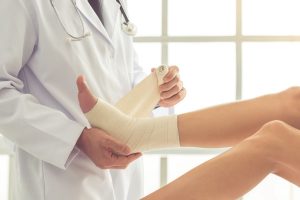Wrapping many layers of gauze over your lower leg and foot creates a compression dressing known as an Unna boot. Protecting an ulcer or exposed wound is a common usage for it. The increased blood flow to the lower leg is a direct result of the compression provided by the dressing. In addition to reducing pain and swelling, compression also aids with circulation. There’s a chance you’ll have to wear the boot for a few weeks, or at least until the wound heals.
What Are Unna Boots Used To Treat?
A good pair of Unna Boots bandages helps reduce the symptoms of edema, ulceration, and sores. Unna Boots are designed to apply pressure to wounds in the range of 20-30 mmHg, which has been shown to hasten healing and lessen discomfort. Treatment of wounds with low to moderate drainage using hydrogel dressings and Unna Boots. The greatest candidates for Unna Boots are those who are ambulatory and able to walk without help.
How do you put on an Unna boot?
A doctor or nurse must put the boot on the patient.
- Approximately 20 minutes should pass while your leg is kept at a right angle to your chest before the boot is put on. A reduction in lower-leg edema should result from this.
- Petroleum jelly-soaked gauze will be applied to your wound.
- Your doctor or nurse will bandage your leg from your toes to your knee. The first layer is a gauze pad saturated with healing creams and ointments. As a next step, we’ll apply a dry gauze dressing of one or two layers. An elastic bandage may be used to secure your leg’s position.
- The drying process will cause the footwear to stiffen. The boot will feel snug at first, but should ease up a bit as you get moving.
- Each time a week passes, your Unna boot will be replaced. At each boot change, your wound will be examined, cleansed, and measured to ensure proper healing.
Unna’s Boot Dressing: A How-To Guide
You can use “loose” or “open” wrapping methods, among others, to secure the bandage.
Even with the Unna wrap on, edema might still increase.
Because of the risk of severe skin and vascular damage, the Unna should be administered using one of the two techniques described below.
Overlay or Loose Wrapping
This wrap may be made with a folding technique. Like an accordion, a wrap that is too slack might open out. To prevent blisters and other foot problems, make sure the accordion folds are flat and positioned at the top of the foot. Starting at the top of the foot, towards the base of the toes, is the traditional place to begin a spiral wrap.
Open Wrapping
You may also make a loose wrap into an open wrap. However, instead of making an accordion fold that can grow, we never shut the bandage at all. For the same reason as the other two techniques, you should begin at the toes while doing an open wrap. Release some of the bandage as if to cover the bottom of the foot, then stop. Roll the bandage in the other way by folding it back over on itself. Turn the wrap around once you reach the top of the foot again.
Both techniques require wrapping the leg from the toes to the fibula, or shin bone, about two to three fingers below the knee. The top of an Unna boot shouldn’t be halfway up the leg.
Finishing
An Unna bandage’s wrapping can be made from anything from paper to plastic to a piece of cloth. Following the application of Unna, the most frequent finishing layer is a cohesive (e.g., Coban) wrap measuring 4 inches in width. Compression of around 15 mmHg is added by this cohesive layer, and the clothes are shielded from the Unna’s paste. Cast padding or an ace wrap are two more options for the outer layer. They do not help with edema reduction and hence are not preferable.
When will my cut stop bleeding?
Make sure your shoe stays dry. Get some advice on how to hide it as you soak in the tub or shower.
Take control of your health by treating issues like diabetes and hypertension. If your health issues aren’t managed, you risk the wound not healing or maybe opening up more. Follow your doctor’s orders and take your medicine. If you have high blood pressure, do what your doctor tells you to do. If you have diabetes, you need to monitor your blood sugar levels as instructed.
Walking everyday will aid in the compression of the boot and the increase of blood flow. You should see your doctor about the optimal daily walking time.
To speed up the healing process after an injury, try eating a wide range of nutritious meals. Fruits, vegetables, whole-grain breads, low-fat dairy products, legumes, lean meats, and fish are all examples of foods that are good for you. Inquire if a change to your diet is required.
Precautions
There are certain people who just shouldn’t be seen dead in an Unna boot. An Unna’s boot is indicated for individuals who are active and not bed or wheelchair confined since it works with muscular contraction to press one-way bicuspid valves open, allowing fluids to flow.
A single application of Unna’s boot wraps might last for up to seven days. However, the dressing has to be changed quickly if drainage produces leaks. The same holds true when wearing the Unna boot wraps in the shower or bath. In either case, the bandage must be kept dry by being wrapped in plastic protection.
Preparation
The Unna’s boot is made of many layers, all of which work together to decrease fluid retention and increase blood flow. Wash the limb, dry it well, and apply a topical treatment to any wounds before beginning the first layer. Lotion or cream, applied lightly, can help keep the skin of your legs healthy and protected from the elements. The wound dressing will stay in place better if the cream or lotion is applied after it has been applied.
The next step is to bend the patient’s foot to 90 degrees to prevent sores from developing on the front of the ankle due to material bunching.

